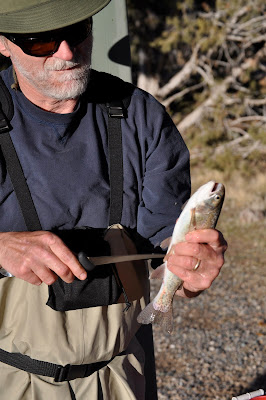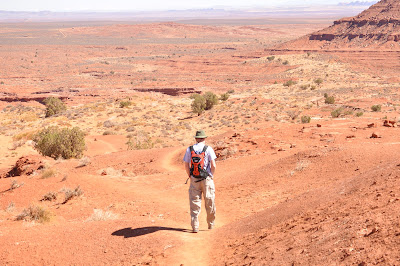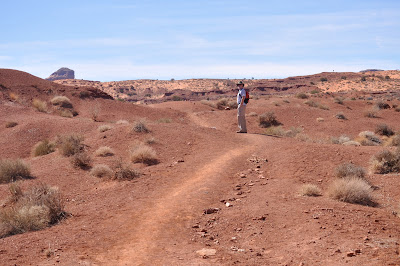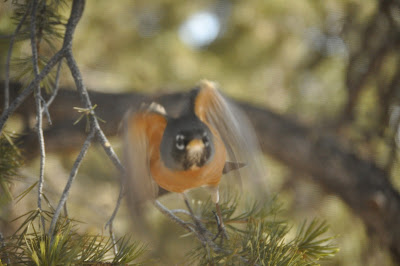Sorry not to have posted immediately after leaving the river, but we had really lousy wifi access at our next stop, so we'll catch you up now.
Ah, Navajo Dam, New Mexico. I fell in love with this place two years ago when we chased
that fly-fishing squirrel to the San Juan River. But the town itself is a bit small for
us to want to live here; it’s around 450 people, 1 convenience store, 2 fishing
motels, 3 cafes, 4 fly shops, and 5 RV parks. You get the idea - everything is geared toward the sports fisherman. But the area is absolutely beautiful! We stayed up at the Navajo Lake State Park around 10 miles outside of
town. The park is a real bargain
at only $14/night with electric and water. There was still snow in the hills when we arrived, but the
weather forecast was for warmer temperatures (low 60’s, much better than
Kansas!) with sunny skies - Mother Nature didn’t disappoint us.
There was still snow on the hills around the lake.
Sunrise over Navajo Lake.
Early the next morning Heinz started pulling out his fishing
gear and taking inventory. This
was followed by a trip into the shops to find out what the locals were
recommending for flies. Of course,
he brought home a few samples for me to start tying. While he was busy with his inventory, I grabbed the camera
and headed out to see if I could find any good spots to practice some macro
photography in preparation for the spring wildflower season coming up.
Cactus in the snow.
Detail, prickly pear cactus
Heinz started out his fishing with a stop at the "catch and
release" area just below the dam and had a nice outing - six rainbow trout. He then headed down to the "catch and
keep" area further down river.
Unfortunately the fish were less cooperative there and he only got a few
nibbles - so no fish for dinner.
The next day he headed straight out to work on dinner and
came home empty handed once again. But this time everyone else on the river was
in the same condition. No one was
even getting a nibble; the fish simply didn’t seem to be feeding. We even overheard a guide and his client talking about how
lousy the fishing had been, the client only caught one brown trout at the very
end of his session, not quite what you expect when you're paying guide prices. But watching
the setting sun on the river was worth being out there.
Oh well, no one else is catching anything either.
Hey Heinz, I think I found that fly you lost yesterday.
Golden light on the river as the sun begins to set.
Setting sun on the hills.
But never fear, the fish started cooperating and over the
time we were there Heinz brought home six nice trout for dinner. We had two fresh fish dinners and
tucked some away in the freezer for up the road.
One day's work - trout dinners in the making.
You gotta love a man that cleans his own fish!
During our 5 days on the river we discussed our proposed
travel plans for the next couple of months and tossed out about half of
them. Really, what fun is a
schedule? So, instead of
immediately heading south to Tucson we’ve added a few side-trips.
Next stop, Monument Valley, Utah. You remember Monument Valley, don’t you? Think back to all those westerns you
watched as a kid. John Wayne, the
Cavalry, Apaches lining up on the top of the mesa, stagecoaches, etc. Yeah, that’s the place.
Driving into Monument Valley.
Mitchell Butte in the rain.
We stayed at Goulding’s Lodge and Campground in the middle
of the Navajo Indian Reservation.
Goulding’s was started in the 1920’s by a couple who bought some land
and started a trading post. When
the depression hit in the 1930’s the reservation was hit extremely hard. The Goulding’s went to Hollywood with
photographs of the area and wrangled a meeting with John Ford - the movie director. He decided that the
valley was the perfect location for his next movie - a Western. Three months later Ford, his film crew and actors arrived to
film “Stagecoach”, John Wayne’s first starring role in a major movie. And behold, a movie location was born
that’s a "must" for any Western worth its weight. The LaFont family purchased the Goulding property in 1981
and the complex now includes the lodge, campground, a museum, small movie
theater (showing vintage John Wayne westerns nightly), two gift shops, a
grocery, laundromat, gas station, convenience store, and restaurant.
Monument Valley, Tsebii’ nidzisgai (The Valley Within the
Rocks) is a sacred place to the Navajo and is located within the Navajo
reservation. The reservation
itself covers almost 30,000 square miles on the Colorado Plateau. Inside Monument Valley is the Monument Valley Navajo Tribal Park. The
park was established in 1958 by the Navajo Nation Council to preserve 92,000
acres of desert landscape covered in mesas, buttes, and spires. There are three words that keep coming
to mind as you move around in this area: mystical, magical, and spiritual.
Rain God Mesa. Mesa
is a Spanish word for table. It is
a rock formation that looks like a table and is usually wide, stable, and the
first geological stage of rock erosion.
Merrick Butte. A
butte is a rock formation that is smaller and the second stage of erosion.
Three Sisters Spire, a Catholic nun facing two
students. A spire is the final
stage of erosion. It is a rock
formation that is narrow and free-standing.
Along with exploring Monument Valley, we hopped on the
motorcycle (Heinz is in seventh heaven having his baby along) and
headed up the road to the Navajo National Monument. There was fresh snow in the area and we took a stroll out to
an overlook to see the ancient cliff dwelling of Betatakin. The Ancestral Puebloans (Anasazi) built
the village around 1250 and lived here for around 50 years before moving away
for unknown reasons, although drought and social pressures are believed to be
factors.
Sandal Trail to Betatakin Overlook.
Betatakin cliff dwellings across the canyon.
The Monument is located along the Old Spanish Trail, the
commercial route used by New Mexican traders traveling to California in the
1830’s. According to the records, it took an average of 12 weeks to reach California and 6 weeks to return. It was once described as “the longest,
crookedest, most arduous pack mule route in the history of America.” The route was used until the mid-1860’s
when the railroad connected the Midwest and San Francisco. It is difficult to see traces of the
trail in the modern landscape.
Most of the trail has been reclaimed by nature, but landmarks such as
the Betatakin ruins can still be seen.
We also took a day to ride the bike from Monument Valley
around the Valley of the Gods. The
entire route was close to 300 miles, but Heinz was in his element. The drive was amazing, curving
highways, gravel roads climbing from the valley floor up to the mesa top via
multiple switchbacks, rough tar-snake filled pavement, hills, desert,
mountains, buttes, mesas, snow, sunny skies, open range grazing with cattle, sheep, horses, even a pig along and on the road, and once again, magical landscapes.
Moki Dugway, 3.5 miles of gravel road, complete with multiple switchbacks climbing
1,100 feet to the top of Cedar Mesa.
Once we got to the top of the mesa it was off to the Natural Bridges National Monument. The
natural bridges were formed by the erosive action of moving water. They were discovered by a prospector in
1883 and designated a national monument by Theodore Roosevelt in 1908.
Heinz and I at Natural Bridges Monument.
Sipapu, a mature span, it endures very little stream erosion
because its abutments stand far from the stream. Sipapu means “place of emergence,” the entryway by which the
Hopi believe their ancestors came into this world.
Kachina is a young bridge where the White Canyon floodwaters
still work to enlarge its span. It
is named for rock art symbols that resemble symbols commonly used on Hopi
kachina dolls.
Owachomo, an old age bridge where streams no longer erode
it, but frost action and seeping moisture do. Owachomo means “rock mound,” a feature atop the bridge’s
east abutment.
Leaving the monument we headed east to Blanding, a small
town in southern Utah where we stopped off for a great little green chile
burger. Next stop was around 40
miles southeast, Hovenweep National Monument. Hovenweep is located about 2 miles from the Colorado/Utah
border on the Cajon Mesa. It is
the location of ancient pueblo ruins built around 1230 and abandoned around 30
years later. The buildings are
quite elaborate for pueblo dwellings—multi-storied, oval, rectangular, and
D-shaped in plan, with detailed masonry.
Archeologists have determined that the buildings served purposes such as
observatories, signaling stations, living and work rooms, storage rooms, and
ceremonial chambers. We hiked the
1.5-mile trail around and through the canyon to get a closer look at all the
ruins.
Hovenweep Castle.
Two D-shaped towers perched on the rim of Little Ruin Canyon, apparently
used for ceremonial purposes.
Twin Towers, together these towers had 16 rooms. The buildings rise from the native
bedrock, their wall almost touching.
One is oval, the other horseshoe shaped. These buildings are among the most carefully constructed
buildings in the entire Southwest.
Square Tower stands in the canyon and is two stories
tall. Located on a large sandstone
boulder, it was built in a slight spiral shape, perhaps for added strength or
for aesthetics.
Unit type house, the name archeologists gave to a basic
building plan, a few living and storage rooms and a small kiva.
Eroded Boulder House incorporates the huge rock under which
it sits as part of its roof and walls.
On top of the boulder are a few shaped stones where a tower once stood.
Leaving Hovenweep it was time to head home in time for
sunset in Monument Valley.
West and East Mitten Buttes at sunset.
On our last day in the valley we headed out to do a small
hike around West Mitten Butte - 3.2 miles through sand, sagebrush, rock, and pinon
trees. It was a beautiful day and
we had a blast!
Starting out on the Wildcat Trail.
Halfway done.
"WOW - that is sharp"... Ahhh - Duh!
Almost back to the car.
We have now left Monument Valley and drifted all the way over to Page, AZ - a scant 140 miles. Tomorrow we'll be exploring the Glen Canyon Recreation Area and the Staircase Escalante, so stay tuned.
Our friends of the day:
This little guy didn’t really think much of us. He kept attacking his
reflection in the windows and mirrors of the rig the entire week we were in
Navajo Dam. I guess we moved into
his mating territory.
Flying into the window in attack mode.
Heinz took this portrait shot of Jabba the Hut in the snow.




































No comments:
Post a Comment